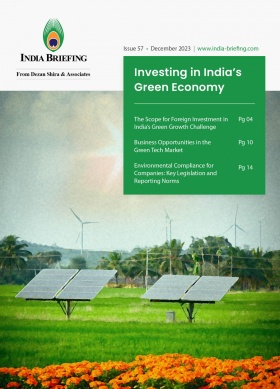Conducting a Market Feasibility Study for Your India-Bound Investment
We explain the importance of conducting a market feasibility study in India for foreign investors seeking to set up for the first time or expand their business and commercial operations in this dynamic and diverse country.
India’s economic outlook
Since the liberalization of the Indian economy in 1991, India’s investment landscape has undergone a remarkable transformation, fueled by a more accommodating regulatory framework and recent relaxation of foreign direct investment (FDI) caps. Over the past decade, India has consistently demonstrated its economic prowess, achieving an average GDP growth rate of 5.5 percent, reflecting its robust and sustained expansion.
The latest projections from both the World Bank and the Reserve Bank of India (RBI) further underline the enduring strength of India’s economic trajectory. The World Bank maintains its outlook for India’s GDP to grow at a formidable 6.3 percent for the fiscal year 2023/24. In parallel, India’s central bank echoes this sentiment by projecting a robust 6.5 percent growth rate for FY 2024. In fact, the RBI foresees continued quarterly growth rates in FY 2024-25, narrowing its initial projection range from 5.5-7 percent to 6.3-6.5 percent.
To succeed in India, businesses must prioritize due diligence to pick investment-friendly and cost-effective destinations best suited to their enterprise needs. For foreign investors, conducting comprehensive feasibility studies is strongly recommended.
The compelling story of India’s economic growth is further substantiated by its stellar performance in the FY 2022/23, where it achieved an impressive growth rate of 7.2 percent. This achievement positioned India’s growth rate as the second highest among G20 countries, nearly doubling the average for emerging market economies. India continued this momentum into the first quarter of FY 2023/24, with GDP surging by 7.8 percent in the period from April to June, marking a significant improvement from the preceding quarter’s growth of 6.1 percent.
In terms of key support factors, India also benefits from having a large demographic base. Now the world’s most populated country, with 1.4 billion people, India is poised to assume a dominant role in the global commercial landscape throughout this decade.
India’s emergence as a significant economic player presents attractive prospects for foreign investors and businesses alike. The country has distinctive attributes, including a dynamic policy environment, large and differentiated consumer markets, and a robust digital infrastructure.
By the year 2031, India is projected to drive one-fifth of global economic growth. This will be underpinned by the convergence of several key trends, including global offshoring capabilities, digital innovation, and a shift towards cleaner energy sources.
India’s favorable demographic profile and consistent growth trajectory overall makes it a relatively safe bet as an investment destination. Over the last two decades, spanning from April 2000 to March 2023, India has successfully secured over US$919.63 billion in total FDI.
Read: India’s Outlook for 2024-25: Key Growth Areas and Investment Prospects
Key drivers of foreign investment in India
Key drivers of foreign investment in India include contemporary factors such as sector-specific production-linked incentive (PLI) schemes, the rapid growth of untapped markets in tier-2 and tier-3 cities, and investment facilitation measures like the National Single-Window System (NSWS). The NSWS simplifies approval and clearance processes for investors, entrepreneurs, and businesses.
Additional factors propelling India’s growth trajectory include high-tech industrial development, the sheer size of its market, and ongoing advancements in the digital and technology ecosystem. Furthermore, strong public investment has driven growth in the construction sector, reflecting India’s commitment to infrastructure development.
Read: Talent Availability in India’s Tier-2 Cities
Where to invest in India
India comprises 28 states and 8 union territories, each characterized by its unique language, culture, outlook, laws, and regulations. Consequently, businesses should remain cognizant of these distinctions when engaging in trade with or planning investments in India, leveraging the diverse strengths of individual states.
Factors influencing investment decisions within India often revolve around the ease of doing business, encompassing aspects like seeking approvals, navigating regulations, liaising with local customs officials, and consumer market appeal. The latter includes considerations such as market size, spending power, purchasing habits, and the availability of a skilled workforce.
The most frequently cited reasons for choosing a business location include the region’s expeditious approval process, efficient bureaucracy, market size, minimal regulations, supportive government policies, and the presence of a skilled labor pool. Additionally, other factors, such as robust physical infrastructure, also come into play.
The importance of making state comparisons in your India market entry planning
Comparing states in India is a critical step in the investment decision-making process. It enables investors to make informed choices that align with their business objectives, reduce risks, and maximize opportunities for success in their sector of operation. Different states offer various advantages and disadvantages, depending on your sector of economic activity, goals, and preferences.
Here, we briefly discuss key factors of consideration:
-
Diverse business environments: India is a vast and diverse country with significant variations in business environments, regulations, and economic conditions across states. Each state has its unique strengths, weaknesses, and specializations. Comparing states allows investors to identify which one aligns best with their business goals and industry.
-
Regulatory variations: State governments in India have the authority to create and implement policies and regulations in their jurisdiction, impacting business and economic activity. These include provisions related to taxation, such as tax on agricultural income, professional tax, value-added tax (VAT), state excise duty, land revenue, and stamp duty, as well as labor laws and environmental clearances, among others. These regulations can significantly impact the ease of doing business. Comparing states helps investors understand the regulatory landscape and its implications.
-
Infrastructure and logistics: Infrastructure quality and logistics play a vital role in business operations. States differ in terms of transportation networks, access to ports, availability of industrial parks, and overall connectivity. Investors need to evaluate these factors to ensure smooth operations and cost-effective logistics.
-
Labor and workforce: Labor availability, skills, and labor laws can vary widely among states. Investors must assess the local labor force’s skills, productivity, and the ease of hiring and firing employees. Understanding labor
conditions is essential for businesses reliant on a skilled or unskilled or highly specialized workforce. -
Industry focus: Different states in India have distinct industrial specializations. For example, Gujarat is traditionally known for its petrochemical industry, while Maharashtra is a financial and manufacturing hub.
Tamil Nadu has a strong automotive and electronics manufacturing sector. Comparing states helps investors identify which region aligns with their industry focus and expertise. -
Incentives and support: State governments often offer incentives and support to attract investments. These incentives may include tax benefits, subsidies, and preferential treatment for specific industries. Comparing states helps investors evaluate which region provides the most favorable incentives for their business.
-
FDI inflows: Look at the FDI equity inflow data for various states, which indicates the level of foreign investment,
presence of MNCs in a particular sector, and therefore business confidence in each state. According to 2021 data, the top five states in terms of FDI equity inflow were Karnataka, Maharashtra, Delhi, Gujarat, and Tamil Nadu. -
Market access: The consumer market in India can vary significantly from state to state due to cultural, economic, and demographic differences. Understanding the local market dynamics is crucial for businesses aiming to
target specific consumer segments. -
Risk mitigation: By comparing states, investors can diversify their geographic risk. Investing in multiple states can reduce exposure to regional economic downturns, political instability, or natural disasters.
-
Local partnerships: In some cases, forming partnerships with local businesses or government entities may be necessary. Choosing the right state for investment involves assessing the availability of suitable partners and
collaborators. -
Long-term viability: A thorough comparison helps investors assess the long-term viability of their investment. Understanding the stability and growth potential of a state’s economy is essential for making sustainable investments.
Conducting a market feasibility study in India
When a foreign investor chooses to locate their investment in a specific Indian state or across multiple Indian states, they must consider doing a market feasibility study. This will allow them to objectively assess the comparative economic, regulatory, infrastructural, and demographic aspects of different locations in a diverse market like India and then make the most informed decisions.
A key challenge during this phase is seeking comparative and updated data sets, as each state publishes statistical information and economic data differently. Often this may be linked to particular goals of the state government and areas of performance that officials want to be highlighted.
Foreign businesses and investors are advised to conduct thorough research, seek local advice, and consult with local experts to navigate the complexities of the Indian investment landscape effectively.
Below we list the factors typically considered in an India market feasibility study:
-
Economic Indicators
- Gross State Domestic Product (GSDP) Growth: Analyze the state’s historical and projected GDP growth rates to gauge economic vitality.
- Sectoral Contribution: Understand the state’s major industries and their contribution to GDP.
- Per Capita Income: Evaluate the average income levels to assess consumer purchasing power.
-
Business Environment
- Ease of Doing Business: Assess the state’s ranking in national and global ease-of-doing-business indices.
- Regulatory Environment: Examine state-specific regulations, taxation policies, customs bureaucracy, and license and reporting requirements.
- Investment Policies: Understand the state’s incentives and support for foreign investors.
-
Infrastructure and Logistics
- Transportation: Evaluate the quality of roads, ports, airports, and railways for efficient movement of goods and people.
- Industrial Zones: Determine the availability of industrial zones or parks for setting up operations.
- Connectivity: Assess how well the state is connected nationally and internationally.
- Land Cost: Evaluate infrastructure and logistics, paying particular attention to land costs, as they play a pivotal role in shaping the economic viability of the project.
-
Workforce and Labor Market
- Labor Force: Analyze the size, skills, and demographics of the local labor force.
- Labor Laws: Understand state-specific labor laws, wage rates, and labor union dynamics.
- Availability of Skilled Workers: Consider the availability of specialized skills required for your industry.
- Labor Costs: Understanding and managing labor costs inform the scale and size of project investment, ensuring long-term profitability.
-
Industry Focus
- Industry Specialization: Identify the state’s key industries and their growth prospects.
- Competition: Analyze the competitive landscape within the chosen industry in the state.
- Supply Chain: Assess the availability and reliability of suppliers and partners.
-
Incentives and Support
- Tax Benefits: Investigate tax incentives, exemptions, and benefits for investors.
- Subsidies: Check for government subsidies and grants available for specific industries.
- Infrastructure Support: Evaluate state-led infrastructure development initiatives.
-
Market Access
- Consumer Base: Examine the size, demographics, and preferences of the local consumer market.
- Distribution Networks: Assess the efficiency and reach of distribution channels.
- Market Potential: Determine the growth potential for your products or services.
-
Risk Assessment
- Political Stability: Consider the state’s political stability and the potential for political disruptions.
- Security: Evaluate the state’s security situation, especially if your investment involves sensitive assets.
- Natural Disaster Risk: Assess susceptibility to natural disasters and the state’s disaster management capabilities.
-
Local Partnerships and Networks
- Government Collaboration: Explore opportunities for partnerships with state government agencies.
- Local Business Partners: Identify potential local partners, suppliers, or distributors.
- Industry Associations: Join industry associations to gain insights and network.
-
Sustainability and Environmental Compliance
- Environmental Regulations: Understand and comply with state-specific environmental regulations.
- Sustainability Initiatives: Evaluate the state’s commitment to sustainable practices.
-
Long-Term Viability
- Economic Trends: Analyze the state’s economic trends and its resilience during economic downturns.
- Infrastructure Development Plans: Investigate the state’s long-term infrastructure development plans.
-
Cultural and Social Factors
- Cultural Sensitivity: Be aware of cultural nuances and local customs that may impact business operations.
- Community Relations: Establish positive relationships with the local community.
-
Legal Due Diligence
- Legal Framework: Understand the state’s legal framework, property rights, and contract enforcement mechanisms.
- Dispute Resolution: Familiarize yourself with dispute resolution mechanisms available in the state.
For any queries on doing a market feasibility study or producing a market entry due diligence report, please feel free to email the author at: koushan.das@dezshira.com
About Us
India Briefing is produced by Dezan Shira & Associates. The firm assists foreign investors throughout Asia from offices across the world, including in Delhi and Mumbai. Readers may write to india@dezshira.com for more support on doing business in India.
We also maintain offices or have alliance partners assisting foreign investors in Indonesia, Singapore, Vietnam, Philippines, Malaysia, Thailand, Italy, Germany, and the United States, in addition to practices in Bangladesh and Russia.
- Previous Article India’s US$2 Billion Green Hydrogen Scheme Highlights Renewables Investment Focus
- Next Article Significance of the Tax Residency Certificate in India








